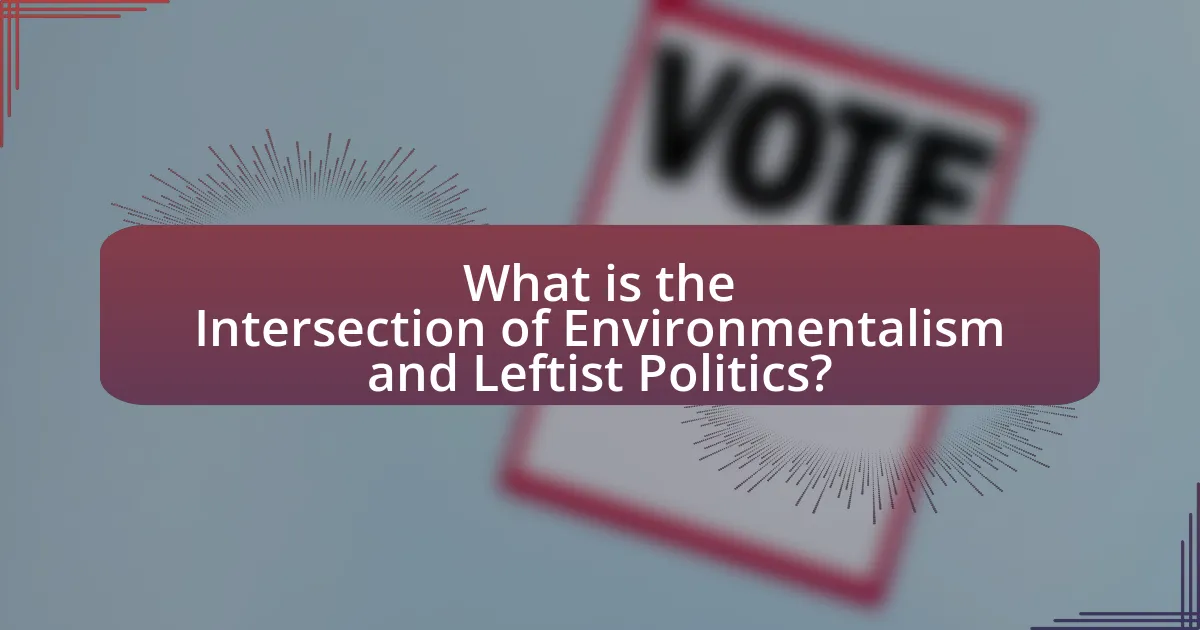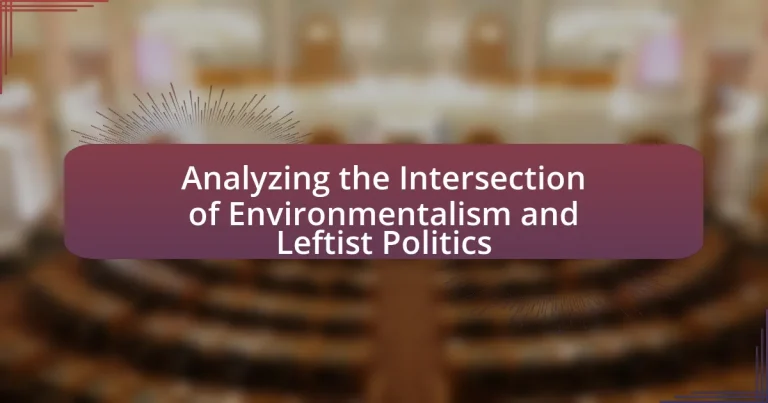The article analyzes the intersection of environmentalism and leftist politics, highlighting their shared focus on social justice, equity, and the critique of capitalism’s role in environmental degradation. It discusses how leftist movements advocate for systemic changes to address climate change, exemplified by initiatives like the Green New Deal, which links ecological sustainability with economic reforms. Key historical events, current trends, and the influence of grassroots activism are examined, along with the challenges faced by these movements, particularly in developing countries. The article emphasizes the importance of integrating environmental concerns with social equity to foster comprehensive policy solutions that benefit marginalized communities.

What is the Intersection of Environmentalism and Leftist Politics?
The intersection of environmentalism and leftist politics is characterized by a shared emphasis on social justice, equity, and the critique of capitalism’s role in environmental degradation. Leftist political movements advocate for systemic changes to address climate change and environmental issues, often linking ecological sustainability with economic and social reforms. For instance, the Green New Deal in the United States exemplifies this intersection by proposing comprehensive policies that aim to combat climate change while promoting economic equality and job creation. This approach is supported by research indicating that marginalized communities disproportionately suffer from environmental harm, thus reinforcing the need for an integrated strategy that addresses both ecological and social concerns.
How do environmentalism and leftist politics relate to each other?
Environmentalism and leftist politics are closely related as both advocate for social justice, equity, and systemic change to address environmental issues. Leftist political ideologies often emphasize the need for government intervention and regulation to combat climate change and protect natural resources, aligning with environmentalist goals of sustainability and ecological preservation. For instance, the Green New Deal, proposed by progressive politicians in the United States, illustrates this relationship by combining economic reform with environmental action, aiming to create jobs while transitioning to renewable energy sources. This intersection is further supported by research indicating that leftist movements tend to prioritize environmental policies that address the disproportionate impact of climate change on marginalized communities, reinforcing the connection between social equity and environmental sustainability.
What historical events have shaped the relationship between environmentalism and leftist politics?
The relationship between environmentalism and leftist politics has been shaped by several key historical events, including the rise of the modern environmental movement in the 1960s, the establishment of Earth Day in 1970, and the emergence of eco-socialism in the late 20th century. The publication of Rachel Carson’s “Silent Spring” in 1962 highlighted the dangers of pesticides, galvanizing public awareness and activism, which aligned with leftist critiques of industrial capitalism. Earth Day, first celebrated in 1970, mobilized millions and solidified environmental issues within the political left’s agenda, emphasizing the need for systemic change. Additionally, the 1980s and 1990s saw the growth of eco-socialism, which integrated environmental concerns with socialist principles, advocating for sustainable practices and social justice. These events collectively illustrate how environmentalism has become intertwined with leftist political ideologies, advocating for a holistic approach to social and ecological issues.
How do leftist ideologies influence environmental policies?
Leftist ideologies significantly influence environmental policies by prioritizing social equity, sustainability, and government intervention in ecological issues. These ideologies advocate for comprehensive regulations aimed at reducing carbon emissions, promoting renewable energy, and protecting natural resources, often through policies like the Green New Deal in the United States, which aims to address climate change while creating jobs and reducing inequality. Historical evidence shows that leftist governments tend to implement stricter environmental regulations compared to their right-leaning counterparts, as seen in countries like Sweden and Denmark, where progressive policies have led to substantial investments in green technologies and a commitment to ambitious climate targets.
Why is the intersection of environmentalism and leftist politics significant?
The intersection of environmentalism and leftist politics is significant because it promotes a holistic approach to social justice and ecological sustainability. Leftist politics often emphasize equity, advocating for marginalized communities disproportionately affected by environmental degradation. For instance, studies show that low-income and minority populations face higher exposure to pollution and climate change impacts, highlighting the need for policies that address both environmental and social inequalities. This intersection fosters movements that seek systemic change, such as the Green New Deal, which aims to create jobs while combating climate change, illustrating how leftist ideologies can drive comprehensive environmental policies.
What are the key challenges faced at this intersection?
The key challenges faced at the intersection of environmentalism and leftist politics include ideological fragmentation, economic constraints, and public perception issues. Ideological fragmentation arises as various factions within leftist politics prioritize different aspects of environmentalism, leading to conflicting agendas. Economic constraints are significant, as leftist policies often require substantial funding and resources, which can be difficult to secure in a competitive political landscape. Public perception issues also pose challenges, as some voters may view environmental policies as economically detrimental or overly radical, hindering broad support for leftist environmental initiatives. These challenges are evidenced by the varied success of environmental policies in left-leaning governments, where internal divisions and economic realities frequently impede cohesive action.
How does this intersection impact social justice movements?
The intersection of environmentalism and leftist politics significantly enhances social justice movements by promoting equity and inclusivity in addressing environmental issues. This synergy fosters a holistic approach that recognizes the disproportionate impact of environmental degradation on marginalized communities, thereby advocating for policies that prioritize social equity alongside ecological sustainability. For instance, the Green New Deal in the United States explicitly links climate action with economic justice, aiming to create jobs while addressing systemic inequalities. This framework illustrates how integrating environmental concerns with leftist ideologies can mobilize diverse coalitions, amplify marginalized voices, and drive comprehensive reforms that benefit both the planet and vulnerable populations.

What are the Core Principles of Environmentalism in Leftist Politics?
The core principles of environmentalism in leftist politics include social justice, sustainability, and anti-capitalism. Social justice emphasizes the equitable distribution of environmental benefits and burdens, advocating for marginalized communities disproportionately affected by environmental degradation. Sustainability focuses on the long-term health of ecosystems and the responsible use of resources to ensure future generations can thrive. Anti-capitalism critiques the profit-driven motives of capitalism that often lead to environmental exploitation, promoting alternative economic systems that prioritize ecological health and community well-being. These principles are supported by various movements and policies aimed at addressing climate change, protecting biodiversity, and promoting renewable energy sources.
What are the main tenets of environmentalism embraced by leftist movements?
The main tenets of environmentalism embraced by leftist movements include ecological justice, anti-capitalism, and sustainability. Ecological justice emphasizes the need to address environmental degradation and its disproportionate impact on marginalized communities, advocating for equitable access to resources and decision-making processes. Anti-capitalism critiques the profit-driven motives of capitalism that contribute to environmental harm, promoting alternative economic systems that prioritize ecological health over profit. Sustainability focuses on long-term environmental stewardship, advocating for practices that ensure the health of ecosystems for future generations. These tenets are supported by various studies and movements, such as the Green New Deal, which seeks to address climate change while promoting social equity.
How do concepts like sustainability and conservation manifest in leftist policies?
Leftist policies manifest concepts of sustainability and conservation through a focus on environmental justice, regulatory frameworks, and public investment in green technologies. These policies often prioritize the reduction of carbon emissions, the promotion of renewable energy sources, and the protection of natural resources, reflecting a commitment to long-term ecological balance. For instance, the Green New Deal in the United States aims to address climate change while creating jobs, demonstrating a holistic approach to sustainability that integrates economic and environmental goals. Additionally, leftist policies frequently advocate for stricter regulations on pollution and resource extraction, emphasizing the need to protect vulnerable communities disproportionately affected by environmental degradation. This alignment with sustainability and conservation principles is evident in various international agreements, such as the Paris Agreement, which many leftist governments actively support to combat climate change.
What role does climate justice play in leftist environmentalism?
Climate justice is central to leftist environmentalism as it emphasizes the need to address the disproportionate impacts of climate change on marginalized communities. Leftist environmentalism advocates for equitable distribution of environmental benefits and burdens, arguing that those who contribute least to climate change, often low-income and minority populations, suffer the most from its effects. This perspective is supported by studies showing that climate change exacerbates existing social inequalities, highlighting the necessity for policies that prioritize the needs of vulnerable groups. For instance, the Intergovernmental Panel on Climate Change (IPCC) reports that climate-related disasters disproportionately affect poorer regions, reinforcing the argument for integrating social justice into environmental policies.
How do leftist political parties incorporate environmental issues?
Leftist political parties incorporate environmental issues by prioritizing sustainability and advocating for policies that address climate change and ecological degradation. These parties often promote renewable energy initiatives, stricter regulations on pollution, and conservation efforts as part of their platforms. For instance, the Green New Deal proposed by the U.S. Democratic Party aims to create jobs in renewable energy sectors while reducing greenhouse gas emissions. Additionally, leftist parties frequently emphasize social justice in environmental policies, arguing that marginalized communities are disproportionately affected by environmental harm. This intersection of environmentalism and social equity is evident in various legislative proposals and grassroots movements championed by these parties.
What specific policies have been proposed by leftist parties to address environmental concerns?
Leftist parties have proposed several specific policies to address environmental concerns, including the Green New Deal, which aims to transition to renewable energy sources and create green jobs. Additionally, many leftist parties advocate for stricter regulations on carbon emissions, investment in public transportation, and the promotion of sustainable agriculture practices. These policies are designed to combat climate change, reduce pollution, and promote social equity by ensuring that marginalized communities are not disproportionately affected by environmental degradation.
How do leftist parties engage with grassroots environmental movements?
Leftist parties engage with grassroots environmental movements by actively collaborating on policy initiatives, supporting local activism, and integrating environmental issues into their political platforms. For instance, many leftist parties advocate for policies that align with the goals of grassroots movements, such as the Green New Deal in the United States, which emphasizes sustainable jobs and climate action. Additionally, leftist parties often participate in protests and campaigns organized by grassroots groups, demonstrating solidarity and amplifying their messages. This engagement is evidenced by the increasing incorporation of environmental justice into leftist agendas, reflecting a commitment to addressing both ecological and social inequalities.

What are the Current Trends in Environmentalism and Leftist Politics?
Current trends in environmentalism and leftist politics include a strong emphasis on climate justice, the Green New Deal initiatives, and grassroots activism. Climate justice advocates argue that environmental degradation disproportionately affects marginalized communities, pushing leftist political movements to prioritize equitable solutions. The Green New Deal, proposed in the United States, aims to address climate change while promoting economic equality, reflecting a growing intersection between environmental policy and social justice. Additionally, grassroots movements, such as Extinction Rebellion and Fridays for Future, mobilize young activists to demand urgent action on climate issues, showcasing a shift towards more radical approaches within leftist politics. These trends highlight a collective recognition that environmental sustainability and social equity are interconnected challenges requiring comprehensive political action.
What recent developments highlight the intersection of these two areas?
Recent developments highlighting the intersection of environmentalism and leftist politics include the Green New Deal initiatives proposed in various countries, which aim to address climate change while promoting social justice and economic equality. For instance, the U.S. Green New Deal, introduced by Representative Alexandria Ocasio-Cortez and Senator Ed Markey, seeks to transition to renewable energy, create green jobs, and reduce greenhouse gas emissions, all while ensuring that marginalized communities benefit from these changes. This initiative reflects a growing trend among leftist political movements to integrate environmental sustainability with social equity, as evidenced by similar proposals in Europe, such as the European Union’s Green Deal, which emphasizes both ecological and social reforms.
How are global movements influencing local leftist environmental policies?
Global movements are significantly influencing local leftist environmental policies by promoting solidarity, sharing strategies, and increasing awareness of environmental issues. For instance, the global climate strikes initiated by movements like Fridays for Future have galvanized local leftist groups to adopt more aggressive environmental policies, as seen in cities that have declared climate emergencies. Research from the Global Environmental Change journal indicates that local governments are increasingly aligning their policies with international climate agreements, such as the Paris Agreement, driven by grassroots activism and global advocacy networks. This alignment often results in enhanced regulations on carbon emissions and the promotion of renewable energy initiatives at the local level, reflecting the broader goals of global environmental movements.
What role do social media and technology play in promoting this intersection?
Social media and technology significantly enhance the visibility and engagement of environmentalism within leftist politics. These platforms facilitate the rapid dissemination of information, allowing activists to share messages, mobilize supporters, and organize events effectively. For instance, campaigns like the Sunrise Movement have utilized social media to amplify their calls for climate action, reaching millions and influencing political discourse. Additionally, technology enables data collection and analysis, which supports evidence-based advocacy, as seen in the use of geographic information systems (GIS) to highlight environmental injustices. This interconnectedness fosters a collaborative environment where diverse voices can unite around shared goals, ultimately strengthening the intersection of these movements.
How do different regions approach the intersection of environmentalism and leftist politics?
Different regions approach the intersection of environmentalism and leftist politics through varying frameworks influenced by local socio-economic conditions and political histories. In Europe, for instance, countries like Sweden and Germany integrate strong environmental policies within their social democratic systems, emphasizing sustainability and social equity, as evidenced by Germany’s Energiewende initiative aimed at transitioning to renewable energy. In contrast, Latin America often sees leftist movements intertwining environmentalism with indigenous rights, as seen in Bolivia’s recognition of the rights of nature in its constitution, reflecting a holistic approach to environmental governance. Meanwhile, in the United States, leftist politics increasingly align with environmentalism through grassroots movements advocating for policies like the Green New Deal, which aims to address climate change while promoting economic justice. These regional differences highlight how local contexts shape the strategies and priorities at the intersection of environmentalism and leftist politics.
What are the unique challenges faced by leftist environmental movements in developing countries?
Leftist environmental movements in developing countries face unique challenges such as limited resources, political repression, and socio-economic inequalities. These movements often struggle to secure funding and support due to the prioritization of immediate economic development over environmental concerns, which is evident in countries like Brazil, where deforestation continues despite environmental activism. Additionally, political repression can manifest through government crackdowns on dissent, as seen in countries like Venezuela, where activists face imprisonment. Socio-economic inequalities further complicate these movements, as marginalized communities may prioritize survival over environmental issues, leading to conflicts within the movement itself.
How do cultural factors influence the environmental agenda in leftist politics across various regions?
Cultural factors significantly influence the environmental agenda in leftist politics by shaping values, priorities, and collective actions regarding environmental issues. For instance, in regions with strong indigenous cultures, such as Latin America, leftist movements often emphasize the protection of natural resources and land rights, reflecting a deep-rooted connection to the environment. This is evident in the Bolivian government’s recognition of the rights of nature, which aligns with indigenous beliefs about the interconnectedness of life and the environment. Additionally, in Europe, cultural factors such as historical experiences with industrialization and environmental degradation have led leftist parties to prioritize sustainability and climate justice, advocating for policies that address both ecological and social inequalities. These cultural contexts create a framework within which leftist politics can mobilize support for environmental initiatives, demonstrating that cultural identity and historical narratives are crucial in shaping the environmental agenda across various regions.
What practical strategies can activists use to strengthen the intersection of environmentalism and leftist politics?
Activists can strengthen the intersection of environmentalism and leftist politics by promoting policies that prioritize social equity alongside environmental sustainability. For instance, advocating for the Green New Deal integrates economic justice with climate action, addressing both environmental degradation and income inequality. Research shows that marginalized communities disproportionately suffer from environmental hazards, making it essential for activists to align their goals with social justice movements. By collaborating with labor unions and community organizations, activists can create a unified front that emphasizes the interconnectedness of ecological health and social welfare, thereby enhancing the effectiveness of their initiatives.
How can coalitions be formed between environmental and leftist organizations?
Coalitions between environmental and leftist organizations can be formed through shared goals, mutual interests, and collaborative strategies. Both groups often prioritize social justice, economic equity, and sustainable practices, which can serve as a foundation for partnership. For instance, the Green New Deal, proposed by leftist politicians, emphasizes environmental sustainability while addressing economic inequality, creating a common agenda for both environmentalists and leftists. Historical examples, such as the collaboration seen during the anti-globalization movement in the late 1990s, demonstrate how these organizations can unite for larger systemic changes. By organizing joint campaigns, hosting forums, and engaging in grassroots activism, these coalitions can amplify their voices and influence policy effectively.
What are effective advocacy techniques for promoting environmental justice within leftist frameworks?
Effective advocacy techniques for promoting environmental justice within leftist frameworks include grassroots organizing, coalition building, and policy advocacy. Grassroots organizing empowers marginalized communities by mobilizing them to demand equitable environmental policies, as seen in movements like the Environmental Justice Movement, which emerged in the 1980s to address the disproportionate impact of pollution on low-income communities and communities of color. Coalition building among diverse groups, such as labor unions, indigenous rights organizations, and environmental NGOs, enhances collective power and broadens the reach of advocacy efforts. Policy advocacy focuses on influencing legislation that addresses systemic inequalities, exemplified by the Green New Deal, which aims to create jobs while addressing climate change and social justice. These techniques are effective because they leverage community engagement, foster solidarity, and promote comprehensive policy solutions that align with leftist values of equity and justice.





